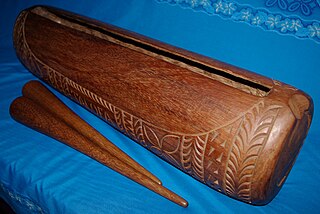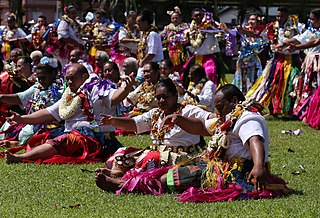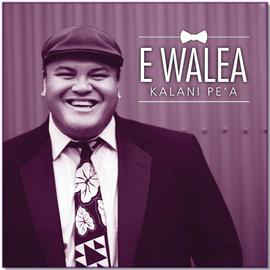Music of Polynesia
Last updatedThe music of Polynesia is a diverse set of musical traditions from islands within a large area of the central and southern Pacific Ocean, approximately a triangle with New Zealand, Hawaii and Easter Island forming its corners. [1] Traditional Polynesian music is largely an inseparable part of a broader performance art form, incorporating dance and recital of oral traditions; most literature considers Polynesian music and dance together. [2] Polynesian music expanded with colonial European contact and incorporated instruments and styles introduced through a process of acculturation that continues to the present day. Although the European tradition of hymn-singing brought by Christian missionaries was probably the most important influence, [3] others are evident; Hawaii's influential kī hōʻalu (“slack key”) music incorporated the Spanish guitar introduced in the late 19th century, and later introduced the steel guitar to country music. [4] Hip hop and R&B influences have created a contemporary Urban Pasifika music genre with a strong Polynesian identity and supported by the annual Pacific Music Awards in New Zealand. [5]
Contents
Christian music
In the 1790s, Christian missionaries arrived in Polynesia for the first time. Hymns and other forms of Christian music were instituted, and native musical genres were driven underground and prohibited. Soon, traditional polyphonic singing was merged with Christian styles and church singing, and along with brass bands became an important part of Polynesian music culture across the Pacific.
Popular music

Popular music in Polynesia is a mixture of more traditional music made with indigenous instruments such as the nose flute in Tonga, and the distinctive wooden drums of the Rarotonga, and local artists creating music with contemporary instruments and rhythms, and also a blend of both. In the 1980s, Fijian stars like Laisa Vulakoro and Lagani Rabukawaqa became popular across the Pacific.
Raiatea Helm is an internationally touring Hawaiian singer who has won has been nominated for the Grammys. [6] Kalani Pe'a is a popular Hawaiian singer songwriter who has also won two Grammys. His music is traditional style Hawaiian songs, and include four-part-harmony oli aloha (greeting chants of appreciation) as well as contemporary Hawaiian music. He also translates popular songs into Hawaiian language. [7] Na Hoku Hanohano Awards are music awards in Hawaii.
There is a form of reggae called Pacific reggae which features different instruments such as the ukulele and Pacific Island drums than reggae in other places. [8] Herbs is a popular New Zealand band in this genre. J Boog (USA) is a reggae performer of Samoan descent based in Hawaii. [8] Chris Boomer is a reggae artists from Guam. [9]
Polynesian heritage artists feature in pop music culture including Dinah Jane (USA) of Fifth Harmony.
Some Polynesian islands have developed a cassette industry, most notably Fiji, Tonga and Samoa.[ citation needed ]
Steel guitar
Popular Hawaiian inspired musicians include steel guitarists Bill Sevesi and Bill Wolfgramm who led popular dance bands during the 1950s. [10]
See also
Related Research Articles
The music of Hawaii includes an array of traditional and popular styles, ranging from native Hawaiian folk music to modern rock and hip hop. Styles like slack-key guitar are well known worldwide, while Hawaiian-tinged music is a frequent part of Hollywood soundtracks. Hawaii also made a contribution to country music with the introduction of the steel guitar. In addition, the music which began to be played by Puerto Ricans in Hawaii in the early 1900s is called cachi cachi music, on the islands of Hawaii.

Music of Tonga refers to music derived from the island Tonga in the islands of Polynesia. Music of Tonga today generally falls under the category of traditional music that has withstood the test of time, or into one of the two opposing genres of religious and secular music. Tongan music can be either very emotional and somewhat modern with instrumental makeup including modern brass instruments, or conversely can be more traditional and consist of only drums and voices. In this way, Tongan music is very diverse despite the fact that it is contained to a fairly small island, which means that the different cultures and styles co-exist on the small land mass together without blending.

The Polynesian Voyaging Society (PVS) is a non-profit research and educational corporation based in Honolulu, Hawaiʻi. PVS was established to research and perpetuate traditional Polynesian voyaging methods. Using replicas of traditional double-hulled canoes, PVS undertakes voyages throughout Polynesia navigating without modern instruments.

Raiatea or Ra'iatea is the second largest of the Society Islands, after Tahiti, in French Polynesia, in the South Pacific Ocean. The island is widely regarded as the "centre" of the eastern islands in ancient Polynesia and it is likely that the organised migrations to the Hawaiian Islands, New Zealand and other parts of East Polynesia started at Raiatea.

The Music of Samoa is a complex mix of cultures and traditions, with pre- and post-European contact histories. Since American colonization, popular traditions such as rap and hip hop have been integrated into Samoan music.

The music of Tokelau occurs in the atolls of Atafu, Nukunonu, and Fakaofo. It is dominated by communal choral activity in harmony, with percussive accompaniment including log drums (pate), pokihi and apa. Nukunonu is notable for traditional song and dance.

Samoans or Samoan people are the indigenous Polynesian people of the Samoan Islands, an archipelago in Polynesia, who speak the Samoan language. The group's home islands are politically and geographically divided between the Independent State of Samoa and American Samoa, an unincorporated territory of the United States of America. Though divided by national border, the culture and language are the same.
The Grammy Award for Best Hawaiian Music Album was an honor presented to recording artists from 2005 to 2011 for quality Hawaiian music albums. The Grammy Awards, an annual ceremony that was established in 1958 and originally called the Gramophone Awards, are presented by the National Academy of Recording Arts and Sciences of the United States to "honor artistic achievement, technical proficiency, and overall excellence in the recording industry, without regard to album sales or chart position".
Polynesian culture is the culture of the indigenous peoples of Polynesia who share common traits in language, customs and society. The development of Polynesian culture is typically divided into four different historical eras:

The culture of the Native Hawaiians encompasses the social behavior, institutions, and norms practiced by the original residents of the Hawaiian islands, including their knowledge, beliefs, arts, laws, customs, capabilities, and habits. Humans are estimated to have first inhabited the archipelago between 124 and 1120 AD when it was settled by Polynesians who voyaged to and settled there. Polynesia is made of multiple island groups which extend from Hawaii to New Zealand across the Pacific Ocean. These voyagers developed Hawaiian cuisine, Hawaiian art, and the Native Hawaiian religion.
Pacific reggae is a style of reggae music found in the Pacific. This style is found in Polynesia, and Melanesia. Within this genre there are differing styles, for example between the New Zealand reggae sound, and that found in the Pacific Islands. According to Herbs co-founder Dilworth Karaka, it is a phrase UB40 came up with.

Polynesian navigation or Polynesian wayfinding was used for thousands of years to enable long voyages across thousands of kilometres of the open Pacific Ocean. Polynesians made contact with nearly every island within the vast Polynesian Triangle, using outrigger canoes or double-hulled canoes. The double-hulled canoes were two large hulls, equal in length, and lashed side by side. The space between the paralleled canoes allowed for storage of food, hunting materials, and nets when embarking on long voyages. Polynesian navigators used wayfinding techniques such as the navigation by the stars, and observations of birds, ocean swells, and wind patterns, and relied on a large body of knowledge from oral tradition. This island hopping was a solution against the scarcity of useful resources, such as food, wood, water, and available land, on the small islands in the Pacific Ocean. When an island’s required resources for human survival began to run low, the island's inhabitants used their maritime navigation skills and set sail for a new island full of possibilities. However, as an increasing number of islands in the South Pacific became occupied, and citizenship and national borders became of international importance, this was no longer possible. People thus became trapped on islands with the inability to support them.

Polynesia is a subregion of Oceania, made up of more than 1,000 islands scattered over the central and southern Pacific Ocean. The indigenous people who inhabit the islands of Polynesia are called Polynesians. They have many things in common, including language relatedness, cultural practices, and traditional beliefs. In centuries past, they had a strong shared tradition of sailing and using stars to navigate at night.

The Peʻa is the popular name of the traditional male tatau (tattoo) of Samoa, also known as the malofie. It is a common mistake for people to refer to the pe'a as sogaimiti, because sogaimiti refers to the man with the pe'a and not the pe'a itself. It covers the body from the middle of the back to the knees, and consists of heavy black lines, arrows, and dots.

The Polynesian Leaders Group (PLG) is an international governmental cooperation group bringing together four independent countries and eight self-governing territories in Polynesia.

Wallis and Futuna, an overseas territory of France in Oceania, has a rich Polynesian culture that is very similar to the cultures of its neighbouring nations Samoa and Tonga. The Wallisian and Futunan cultures share very similar components in language, dance, cuisine and modes of celebration.

Kalani Peʻa is a three-time Grammy Award winning singer-songwriter of Hawaiian music. He released his first album, E Walea, in 2016, which won the 2017 Grammy award for Best Regional Roots Music Album. Peʻa released his second album, No 'Ane'i, in 2018, which won the Grammy Award for Best Regional Roots Music Album at the 61st Annual Grammy Awards.

Ho'okena is a Hawaiian music trio which consist of the members Horace K. Dudoit, Chris Kamaka and Glen Smith. The group was created in 1986 and remains one of the longest lasting Hawaiian music groups. Ho'okena has been nominated for the Grammy Awards three times and has won multiple Na Hoku Hanohano Awards.

E Walea is the debut album by Hawaiian singer Kalani Pe'a. It was released on August 5, 2016.
Angélo Ariitai Neuffer or Angelo is a French Polynesian singer-songwriter and guitarist. He is one of the most prolific Polynesian singers: to date, he has written and composed over two hundred original songs and released sixteen solo albums and four duo albums. With Barthélémy, Bobby Holcomb and Jean Gabilou, he is considered one of the most popular Polynesian singers of his generation.
References
- ↑ McLean 1999, p. 3.
- ↑ Kaeppler, Adrienne. "Oceanic music and dance". Encyclopædia Britannica . Retrieved 14 September 2020.
- ↑ McLean 1999, p. 431.
- ↑ Ross, Michael (February 17, 2015). "Pedal to the Metal: A Short History of the Pedal Steel Guitar". Premier Guitar Magazine. Retrieved September 1, 2017.
- ↑ "Pacific Music Awards Announced". Scoop (Press release). Pacific Music Awards. 23 November 2004. Retrieved 14 September 2020.
- ↑ "Raiatea Helm". GRAMMY.com. 2020-11-23. Retrieved 2021-09-11.
- ↑ "2018 National Artist Fellow and Grammy Winner Kalani Pe'a tours the West Coast". Native Arts and Cultures Foundation. 2018-03-17. Retrieved 2021-01-18.
- 1 2 "Reggae Superstar J Boog to Play in Small Town New Zealand | Scoop News". Scoop. 2011-01-30. Retrieved 2021-01-18.
- ↑ "Biography: Chris Boomer". Reggaeville. Retrieved 2021-01-18.
- ↑ "The history of recording in New Zealand". National Library of New Zealand. Archived from the original on 25 May 2010. Retrieved 20 July 2010.
Bibliography
- McLean, Mervyn (1999). Weavers of song: Polynesian music and dance. Auckland University Press. ISBN 186940212X.
- Linkels, Ad. "The Real Music of Paradise". 2000. In Broughton, Simon and Ellingham, Mark with McConnachie, James and Duane, Orla (Ed.), World Music, Vol. 2: Latin & North America, Caribbean, India, Asia and Pacific, pp 218–227. Rough Guides Ltd, Penguin Books. ISBN 1-85828-636-0
- Hebert, D. G. (2008). Music Transmission in an Auckland Tongan Community Youth Band, International Journal of Community Music, 2(1).
- Hebert, D. G. (2008). Music Transculturation and Identity in a Maori Brass Band Tradition. In R. Camus & B. Habla, Eds. Alta Musica, 26, pp. 173–200. Tutzing: Schneider.
Text is available under the CC BY-SA 4.0 license; additional terms may apply.
Images, videos and audio are available under their respective licenses.